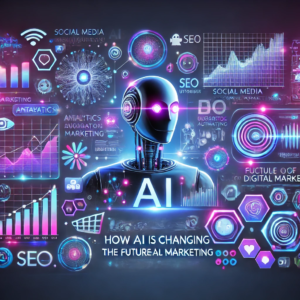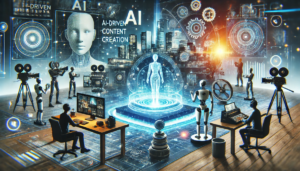Why AI-Powered Businesses Are Growing 10x Faster
AI-powered businesses are revolutionizing industries by delivering unprecedented growth at remarkable speeds. These organizations harness artificial intelligence to automate complex processes, accelerate decision-making, and unlock insights that would otherwise remain hidden.
The transformative power of AI isn’t limited to tech giants or specialized firms—entrepreneurs across all sectors are implementing these capabilities to dramatically outpace competitors.
This technological revolution represents a fundamental shift in how business value is created and sustained.
When entrepreneurs embrace AI-powered solutions strategically, they gain access to capabilities previously available only to enterprises with massive resources and specialized teams.
Today’s AI tools democratize access to sophisticated capabilities, enabling small teams to accomplish tasks that once required dozens of specialized professionals.
We strongly recommend that you check out our guide on how to take advantage of AI in today’s passive income economy.
Table of Contents
The Reality of AI Transformation
The business landscape is evolving rapidly, with AI-powered organizations consistently outperforming their traditional counterparts.
This acceleration isn’t merely incremental—companies effectively leveraging AI technologies often experience growth rates ten times faster than industry averages.
This exponential advantage comes from AI’s ability to handle repetitive tasks, identify patterns in massive datasets, and generate creative solutions to complex problems.
Business leaders who recognize this potential gain what amounts to additional team members with extraordinary capabilities—without the corresponding overhead costs.
As these technologies continue developing, the performance gap between AI-adopters and traditional operations will only widen.
Redefining Human Potential With AI
Our understanding of what constitutes “inhumane” work evolves continuously as technology advances.
Previously, dangerous physical labor represented obviously inhumane conditions, but today’s perspective encompasses tedious cognitive tasks as well.
Activities like manually transferring data between systems, performing repetitive calculations, or combing through documents for specific information increasingly seem inappropriate for human workers.
AI systems excel at precisely these types of structured, repetitive tasks that drain human creativity and engagement.
By delegating these responsibilities to AI systems, organizations free their human talent to focus on innovation, relationship-building, and strategic thinking.
This fundamental shift represents not just efficiency gains but a more humane approach to work itself.
The Swiss Army Knife of Business Performance
Today’s most effective business leaders recognize AI as a versatile tool that amplifies capabilities across every function.
These technologies deliver value throughout organizations—from marketing and sales to operations, product development, and customer service.
The most successful implementers understand that AI isn’t merely another technology investment but a fundamental business capability multiplier.
When properly deployed, these systems function like having dozens of specialized consultants available around the clock.
Industry pioneers have already demonstrated how AI integration creates sustainable competitive advantages through both cost reduction and revenue expansion.
Cutting Through the AI Noise
Despite tremendous potential, many executives struggle to separate practical AI applications from overhyped promises.
The marketplace overflows with vendors claiming revolutionary capabilities, making it challenging to identify truly valuable solutions.
Successful AI implementation requires focusing on commercial applications with immediate revenue potential rather than technical sophistication alone.
The most valuable AI tools deliver measurable business outcomes—increased sales, reduced costs, improved customer satisfaction, or accelerated product development.
This practical approach distinguishes successful AI adopters from those distracted by technological novelty without clear business purposes.
Practical AI Applications for Entrepreneurs
Content Creation and Personalization
AI systems now generate professional-quality written content, videos, images, and interactive experiences in minutes.
These capabilities democratize media production, enabling small teams to create materials previously requiring specialized studios and extensive resources.
Modern AI tools produce multiple creative variations simultaneously, allowing rapid testing and refinement of marketing messages.
This accelerated development cycle means businesses can experiment more extensively and identify winning approaches much faster.
The combination of quality, speed, and iteration capabilities transforms marketing from a resource-intensive constraint into a scalable advantage.
Real-Time Translation and Global Reach
Language barriers historically limited business expansion, requiring significant investments in translation and localization.
Today’s AI translation tools operate in real-time with remarkable accuracy, enabling seamless communication across languages.
These capabilities extend beyond text to include voice, video dubbing, and cultural context adaptation.
Entrepreneurs can now engage international customers directly through their preferred languages without maintaining multilingual teams.
This accessibility dramatically accelerates global market entry and expansion strategies while reducing traditional costs.
Customer Support Transformation
AI-powered support systems handle routine inquiries with human-like responsiveness while continuously improving through interaction.
These systems operate 24/7 without fatigue, ensuring consistent customer experiences regardless of volume or timing.
Modern implementations seamlessly transfer complex situations to human agents with complete conversation context.
This hybrid approach delivers superior customer experiences while reducing operational costs and enabling scale.
Organizations implementing these solutions typically see support costs decrease while satisfaction metrics improve significantly.
AI-Enhanced Decision Making
Advanced analytics capabilities process vast information volumes to identify patterns invisible to human analysts.
These systems continuously monitor business operations, market conditions, and customer behaviors to surface actionable insights.
Decision-makers receive contextualized recommendations rather than overwhelming data dumps requiring extensive analysis.
This acceleration compresses decision cycles from weeks to hours or minutes in many scenarios.
Organizations leveraging these capabilities consistently outmaneuver competitors through faster, more informed strategic adjustments.
Building Your AI-Powered Visual Brand
Traditional visual branding required expensive design services and extensive revision cycles, creating barriers for smaller organizations.
Today’s AI design tools generate professional-quality graphics, animations, and visual assets based on simple text descriptions.
These systems produce multiple variations simultaneously, enabling rapid testing and refinement of visual approaches.
The democratization of design capabilities enables consistent, high-quality visual communication across all customer touchpoints.
This accessibility transforms branding from a periodic, resource-intensive project into an ongoing, responsive process.
Prototype Development and Testing
Product development historically involved lengthy cycles of physical prototyping, testing, and refinement.
AI-powered simulation environments now enable rapid virtual prototyping across countless variations and scenarios.
These capabilities compress development timelines while simultaneously improving final product performance.
Organizations can test customer reactions to concepts before investing in production infrastructure.
This approach dramatically reduces development costs while accelerating time-to-market for new offerings.
Business Model Innovation Through AI
Beyond operational improvements, AI enables entirely new business models previously impossible to execute.
Hyper-personalization at scale creates opportunities for customized products and services without corresponding cost increases.
Predictive systems enable proactive service models that address customer needs before they become apparent.
Dynamic pricing models maximize revenue while expanding market access through optimized affordability.
Organizations leveraging these capabilities often disrupt established markets by delivering superior value propositions.
The Financial Impact of AI Implementation
Early AI adopters consistently report extraordinary returns on their technology investments.
Initial implementation costs continue decreasing while capability improvements accelerate, creating attractive economics.
Many organizations experience productivity improvements of 30-50% in AI-enhanced functions within months.
Revenue impacts frequently exceed operational savings as AI uncovers opportunities invisible through traditional analysis.
This combination of cost reduction and revenue enhancement creates multiplicative financial benefits.
Overcoming Implementation Challenges
Despite compelling benefits, many organizations struggle with effective AI implementation.
Successful adoption requires focusing on specific business outcomes rather than technological sophistication.
Starting with clearly defined, high-value use cases builds organizational momentum and capabilities.
Effective implementations typically begin with processes where data quality is high and outcomes are easily measured.
This methodical approach builds organizational confidence while developing internal expertise for more complex applications.
The Future of AI-Powered Business Growth
Current capabilities represent merely the beginning of AI’s business impact.
Next-generation systems will demonstrate increasingly sophisticated reasoning, creativity, and problem-solving capabilities.
Organizations developing AI implementation expertise today position themselves for accelerating advantages as capabilities expand.
The performance gap between AI-powered organizations and traditional operations will continue widening.
This trajectory makes AI adoption not merely advantageous but increasingly essential for organizational survival.
Creating an Unfair Advantage
Business leaders naturally seek competitive advantages rather than level playing fields.
AI implementation creates legitimate, sustainable advantages through superior capabilities and economics.
Organizations leveraging these technologies essentially operate with expanded intellectual resources without corresponding costs.
These capabilities compound over time as systems continuously learn and improve through operation.
This compounding effect explains why AI-powered businesses consistently achieve growth rates multiples higher than industry averages.
Conclusion
AI-powered businesses achieve extraordinary growth through capability amplification across all functions.
These organizations leverage artificial intelligence to operate faster, smarter, and more efficiently than traditional competitors.
The democratization of advanced AI capabilities enables organizations of all sizes to implement transformative technologies.
Forward-thinking leaders recognize this opportunity not merely as a technology trend but as a fundamental business revolution.
Those embracing these capabilities position themselves to thrive amid accelerating change while others struggle to maintain relevance.
Key Takeaways for Implementing AI in Your Business
Start with clearly defined, high-value business problems rather than technology exploration.
Prioritize applications with immediate revenue or cost-saving potential to build organizational momentum.
Develop implementation approaches that combine AI capabilities with human expertise rather than complete replacement.
Focus on augmenting your team’s capabilities through technology rather than workforce reduction.
Establish continuous learning systems that improve through operation rather than static implementations.

We strongly recommend that you check out our guide on how to take advantage of AI in today’s passive income economy.




